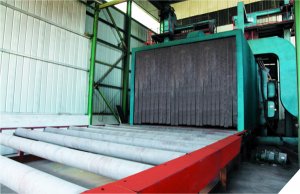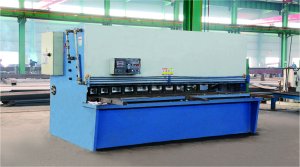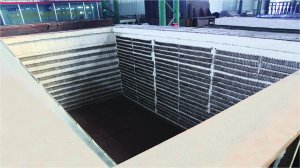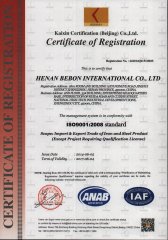QStE380TM is a hot-rolled high-strength low alloy (HSLA) steel commonly used in the manufacture of cars, trucks, ships, bridges and other structural parts. Carbon (C): The carbon content of QStE380TM steel is generally between 0.12% and 0.20%, which is controlled within an appropriate range to ensure good welding performance and strength. Manganese (Mn): Manganese content, typically between 1.40% and 1.60%, helps increase the strength and hardness of steel. Silicon (Si): Silicon content is generally controlled below 0.50%, which can adjust the deformation hardening ability and cold forming performance of steel. Phosphorus (P) and Sulfur (S): The content of these two elements is usually limited to low levels to ensure good welding and processability. Other trace elements: QStE380TM steel may contain small amounts of chromium (Cr), molybdenum (Mo) and other trace elements to adjust the specific properties of the steel.
QStE380TM steel has high yield strength and tensile strength, typically between 380 MPa and 450 MPa, making it ideal for structural parts that are subject to high loads and impacts. This high strength allows structural members to maintain stability and safety when subjected to external loads. QStE380TM steel has good cold forming properties and is suitable for cold bending of complex shapes and small radii, such as deep drawing, bending and stretching. This property makes it widely used in fields such as automobile manufacturing, machining and structural engineering. The steel has excellent welding properties and can be joined by conventional welding methods such as arc welding, TIG welding and laser welding. The welded joints have good strength and sealing properties and can meet the requirements of engineering structures. After proper heat treatment and surface treatment, QStE380TM steel has good corrosion resistance and can operate stably in the atmosphere, water and chemical media for a long time. This makes it of great application value in fields that require weather resistance, such as marine engineering, chemical equipment, and automotive parts. QStE380TM steel has good impact toughness and can maintain good plasticity and impact resistance even under low temperature conditions. This makes it suitable for engineering projects and structural component manufacturing in cold regions or cold climates. The production of QStE380TM steel adopts modern steelmaking technology and processes, which can control energy consumption and waste emissions and reduce the impact on the environment. In addition, the steel has good recyclability and can be recycled through smelting and regeneration, helping to reduce resource consumption and waste generation.
QStE380TM steel has good prospects in the market, which is mainly reflected in the following aspects: The automobile manufacturing industry is one of the main markets for QStE380TM steel. As the demand for automobile lightweighting, energy conservation and environmental protection continues to increase, QStE380TM steel, as a high-strength low-alloy steel, has a high strength-to-weight ratio and is suitable for manufacturing body structures, chassis components and safety-critical components. With the rise of electric vehicles and hybrid vehicles, the demand for QStE380TM steel will further increase. The construction engineering sector is another important market. QStE380TM steel is widely used in construction and infrastructure projects, such as the manufacture of bridges, high-rise buildings, overpasses and other structural components. Its high strength and good cold forming performance enable it to meet the design requirements of various complex structures, while achieving lightweight design of the structure and improving the performance and safety of the building. The machinery manufacturing industry is also one of the important markets for QStE380TM steel. This steel is widely used in manufacturing machinery and equipment, heavy machinery and industrial machinery parts. Its excellent mechanical properties and good cold forming properties allow it to withstand high loads and complex shape requirements while maintaining structural stability and durability. In the energy sector, QStE380TM steel is often used to manufacture key components such as wind turbines, solar racks and oil and gas pipelines. Its corrosion resistance and high strength enable stable operation in harsh environmental conditions, providing reliable support for renewable and traditional energy facilities. In the fields of shipbuilding and offshore engineering, QStE380TM steel is used to manufacture hull structures, offshore platforms and offshore structures. Its corrosion resistance and good impact toughness enable it to withstand the harsh conditions of the marine environment, ensuring the safety and reliability of ships and offshore facilities. To sum up, QStE380TM steel has broad market prospects. With the increasing requirements for high strength, lightweight and durability, its application in automobile manufacturing, construction engineering, machinery manufacturing, energy industry and shipbuilding will be Continue to expand. With the advancement of technology and changing market demands, QStE380TM steel is expected to achieve greater development space in the future.
Overall, QStE380TM steel is a high-strength low-alloy steel with excellent mechanical properties and versatility, and is widely used in automotive manufacturing, structural engineering, shipbuilding and other fields. Its chemical composition and properties are precisely controlled to meet the material strength, durability and processing performance requirements of different engineering projects.

 Address:Zhengzhou city in China.
Address:Zhengzhou city in China. Phone:0086-371-86151827
Phone:0086-371-86151827 Email:
Email:



 Address: Zhengzhou city in China.
Address: Zhengzhou city in China.


